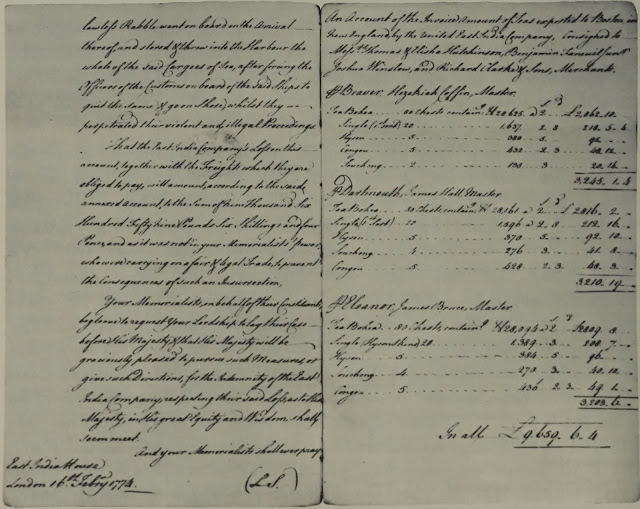The Second Boston Tea Party: Part I
The Second Boston Tea Party: Part I
 |
| Detail of Philip Dawe's mezzotint "The Bostonians Paying the Excise-Man or Tarring and Feathering" (October 1774). This corner detail is the first known depiction of the destruction of tea in Boston Harbor. Who's to say if Dawe is depicting the first or the second, or both? |
On March 7, 1774 a cargo of tea was destroyed in Boston Harbor. The event—now known as the Second Boston Tea Party—is often relegated to no more than a footnote in American history (if even that). Even Joseph Cummins' book "Ten Tea Parties: Patriotic Protests that History Forgot" gives it no more than two paragraphs in the appendix. [1] While the Second Boston Tea Party certainly lacked the scale and notoriety of its namesake on December 16, 1773, it was nonetheless an important moment in the increasing tensions between Great Britain and the American Colonies. I'd like to offer here what I believe to be the most thorough telling of the story of that second destruction of tea in Boston Harbor. First, however, let's review the background events leading up to this moment, and particularly lay out the timeframe that will be crucial to how the event played out.
Background
The Tea Act went into effect in May 1773. It granted the East India Company (EIC) a great advantage in the American tea trade by allowing them to ship tea directly to America on their own account, rather than offering it for sale at the London auction. This threatened to cut out middleman merchants in both London and the colonies. Additionally, for all tea that was shipped to the American colonies, the Tea Act awarded a drawback of the duties typically owed when that tea was first imported into England. These two measures allowed the EIC to offer their tea at a very attractive price, one that could even compete with the price of tea smuggled in from other European nations.
What the Tea Act did not do though, was remove the 3 pence per pound duty that was laid on American imports of tea as part of the Townshend Revenue Act in 1767. The Townshend duties on tea and other goods caused quite a commotion in the colonies, as it was yet another point of conflict between the British Parliament attempting to assert their absolute authority over the colonies and American colonists rejecting Parliament's claim to such authority due to a lack of colonial representation in that body. This conflict lead to protests and boycotts, which eventually saw the repeal of most of the duties Parliament attempted to levy. The duty on tea, however, was left in place, and continued to be a thorn in the side of colonists, many of whom then perceived the Tea Act as a sneaky attempt to trick them into paying the tea tax.
The East India Company for their part wasted no time in taking advantage of this new law. They quickly put together their first shipment of tea for America: over 2000 chests holding nearly 600,000 lbs. of tea. Once assembled they hired vessels heading to America—seven in all—to transport the tea. Four vessels sailed to Boston, and one each sailed to New York, Philadelphia, and Charleston. These vessels all left London in late-September/early–October and began arriving in America in late-November/early-December.
Opposition in the colonies to the Tea Act didn't really get going until October—by which point the ships carrying EIC tea were already on their way. On October 16 a town meeting in Philadelphia [2] adopted eight resolutions denouncing the Tea Act and the Townshend tea duty. The so-called Philadelphia Resolutions became the cornerstone of American resistance during the Tea Crisis. On November 5 Boston citizens held their first town meeting [3] to address the brewing crisis, and they adopted the Philadelphia Resolutions to represent their own sentiments. They also reiterated the past agreement of many merchants to withhold importation of tea until the Townshend duty was repealed—an agreement that up to that point had had a somewhat lackluster execution in Boston. [4]
The timing of all of these events is crucial for how the Second Boston Tea Party played out, which we'll begin to explore next.

Comments
Post a Comment